Photographs by David Stonner
When it comes to fishing in Ozark streams, smallmouth bass and goggle-eye are the species to catch. At the top of the food chain, they consume great quantities of prey and few other fish prey upon them as adults. They fight like the dickens on the end of a line, and they are a source of envy and legend for many anglers. Learning the details of these fishes’ lives helps biologists manage quality fisheries and improves anglers’ success.
Where to Find Them
Smallmouth bass and goggle-eye have similar distributions in the U.S., occurring mainly in the upper Midwest. In Missouri, they are typically found in greatest numbers in streams, but smallmouth bass also do well in reservoirs. The permanent flow, clear water, abundant cover, and silt-free bottoms of many Ozark streams and a few northeastern Missouri streams provide the needed habitat for these species to thrive. In addition to rocky or woody in-stream structures and clear water, cool temperatures are important for these species; smallmouth typically don’t do well in water higher than 85 degrees Fahrenheit, so shade and groundwater inputs (springs) are important in their conservation and management.
Access to Missouri streams is widely available through Conservation Department lands and accesses, other state agency and federal lands, road rights-of-way, and by securing permission from private streamside landowners. Many Ozark streams are accessible through commercial outfitters who rent canoes, kayaks, or rafts for floating and fishing. Anglers can fish from the bank, wade, or float. Floating is most often by canoe and kayak, but on larger streams, powered boats can be used. Respect for other stream users and streamside landowners is key to ensuring that Missouri’s streams remain available for all Missouri citizens to enjoy.
Best Baits Presentation
Catching smallmouth and goggle-eye on an Ozark stream can be simple. During the day you can find them in deep water near the bottom, usually near boulders and snags that lie in noticeable current. They are most active at night, when they will often strike noisy surface lures. Any small plug will catch them, but a deep-running crawdad imitator is one of the most consistent. Both species also seem to be particularly fond of soft plastic baits. A favorite of many anglers is a 3-inch curly-tailed grub or 4-inch worm, especially those that have been impregnated with salt. Almost any color will work, but darker colors seem more productive. Any sort of tackle is fine, but many anglers prefer using an ultralight rod matched with an open-face spinning reel and spooled with 4-pound test line.
Smallmouth bass and goggle-eye feed on similar prey — primarily crayfish, followed by insects and small minnows. Having adequate prey available ensures that fish will grow from one year to the next, and having good growth rates ensures that abundant numbers of juvenile fish will be ready to move into more desirable sizes for anglers as the years go by.
Building Better Fisheries
A fish is only concerned with its most immediate needs — food, a protected, cool place to rest, and a place to ride out flood events. However, biologists are concerned about entire populations, and they know that multiple nesting areas, plentiful juvenile habitat (think protection from predators), and abundant adult resting and feeding areas ensures continued survival on a larger scale. All of these habitat components require healthy watersheds and streams with relatively high gradients, rocky substrates, and timbered riparian corridors, and they are determined by the stream’s geology and surrounding land use. Recent studies by the National Park Service and University of Missouri (May 2013; Tracking River Smallmouth) have shown the additional importance of springs that buffer water temperature fluctuations. They seem to reduce stress on smallmouth and goggle-eye during extreme hot and cold periods. The studies highlight critical habitat areas that need to be conserved to sustain quality smallmouth and goggle-eye populations in the future.
Even in the best habitat, some smallmouth or goggle-eye simply will not survive from one year to the next. This “annual mortality rate” is an important component to shaping the fishery in a water body. Recent Conservation Department-led studies are helping biologists determine how much smallmouth annual mortality is due to angler harvest versus other causes. On average in the U.S., natural mortality rates of smallmouth are around 40 percent. This means that in an un-fished population, if 100 fish were alive at the beginning of the year, only 60 would be left alive at the end of the year, simply due to natural causes (old age, disease, environmental, predation, etc.). Understanding how much mortality is due to angler harvest and modeling the outcomes of altering harvest rates helps biologists determine harvest regulations.
Anglers and biologists alike want to see that quality fisheries exist wherever possible. To consistently produce a quality fishery, streams need habitat that supports all fish life stages and provides for acceptable growth and survival. With appropriate habitat, a stream can produce good numbers of young fish that grow and survive successive years to become the larger fish that anglers desire. If a stream has only good juvenile fish habitat but lacks adult habitat, or only has good habitat every now and then, fish don’t grow well or survive long enough to reach those bigger sizes.
Understanding what a given stream is capable of producing keeps biologists and anglers from having unrealistic expectations. In some streams, a 10-inch smallmouth or 7-inch goggle-eye is a long-lived, quality fish. In other steams, those sizes are more commonplace, and anglers can expect to encounter larger fish more consistently. Knowing growth rates and annual mortality rates help biologists predict whether a stream is producing an optimum fishery, or if there is potential for improvement. Realizing where regulations can improve populations and not create false hopes for anglers is important to the Conservation Department, as we strive to provide quality fishing experiences for all Missourians.
Smallmouth and Goggle-Eye Fish Facts
Growth
On average, it takes a smallmouth bass five years to attain a length of 12 inches, and a goggle-eye five years to reach 8 inches. Growth may be faster or slower depending on a fish’s habitat — in reservoirs and some larger streams, some smallmouth bass can reach 12 inches in three years, but in small streams it may take six or more years to reach 12 inches. Few smallmouth bass live more than 7 years, and few goggle-eyes live more than 5 or 6 years.
Sources of Mortality
Ozark streams are not easy places to live, and there are many sources of mortality for both smallmouth and goggle-eye over a year’s time: disease, difficulty finding enough food, changing water temperatures and levels, loss of protective resting places, natural predators, etc. Anglers sometimes make up part of that mortality. Mortality rates describe how many fish survive from one year to the next, and managers need to understand how much mortality is attributable to anglers compared to “natural” sources when considering the effects of potential fishing regulations.
Regulations and Special Management Areas
Where angler-induced mortality appears high compared to natural sources, restricting angler harvest can improve the numbers and sizes of fish available. This is the emphasis behind designating Stream Special Management Areas — to reduce high angler harvest levels so that more and larger fish can grow. If angler harvest is not a significant part of the total fish mortality, changing harvest regulations will yield little improvement in fish sizes and numbers. Also, a stream that allows more harvest can yield just as good or better fishing than restricted harvest areas. Smallmouth bass and goggle-eye regulations are meant to control harvest, not describe where the best fishing is.
Maps
Locations of Stream Black Bass Special Management Areas and other smallmouth stream accesses are available in the Ozark Smallmouth Bass Fishing map, online at mdc.mo.gov/node/5876. Maps of Conservation Department areas and stream accesses are available online at mdc.mo.gov by accessing the Conservation Area Atlas (bottom left of home page). You may also request a map by emailing our publications staff at Pubstaff@mdc.mo.gov, or mail your request to Publications, Missouri Department of Conservation, PO Box 180, Jefferson City, MO 65102-0180.
So Many Ways to Fish
Missouri’s Ozark streams are great fishing destinations for smallmouth bass and goggle-eye. Anglers primarily wade or float most of these relatively shallow waterways.
From watercraft such as canoes, kayaks, float tubes, or Jon boats, an angler can fish a considerable amount of stream in a day’s time. Floating is also very relaxing, allowing you to simply ride with the current and cast into likely looking areas. Some watercraft are equipped with mounts for electric or outboard motors that allow for boat control and/or access to locations both up and downstream. If you don’t own a boat, outfitters who rent a variety of watercraft are available on many of the larger streams in the Ozarks.
Wade fishing is more common along smaller streams that are difficult to access by other means. As you move slowly while wade fishing, you can see wildlife and natural features missed from a boat. Wading anglers often catch large fish since they are able to cast repeatedly into good spots. Many anglers use a combination of floating and wading to access remote reaches of streams. Always ask permission before floating or wading through private property.
Fishing for smallmouth and goggle-eye in Ozark streams can be as simple or complex as anglers want to make it. Anglers can use a cane pole with a few worms and a hook, a pocket full of lures and a spinning rod, or a jet-powered boat with a dozen rods and a mountain of artificial lures. Pole and line, fly casting, spinning/spin casting, or bait casting methods all can be used successfully. Crayfish and small fish are primary prey items for smallmouth and goggle-eye, so capturing a few to use as bait or using lures that imitate them are the best ways to be successful.

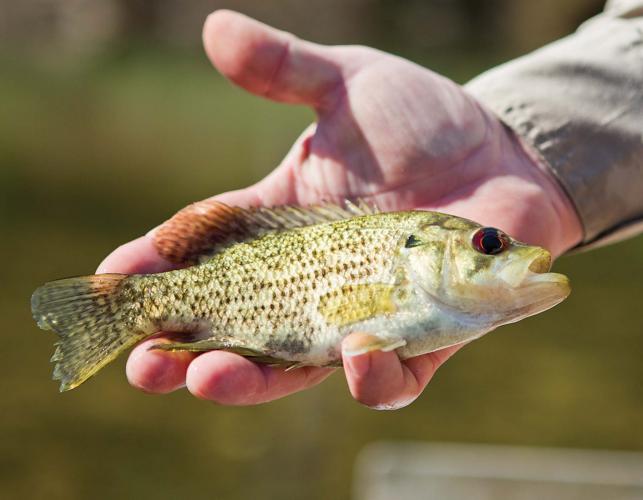
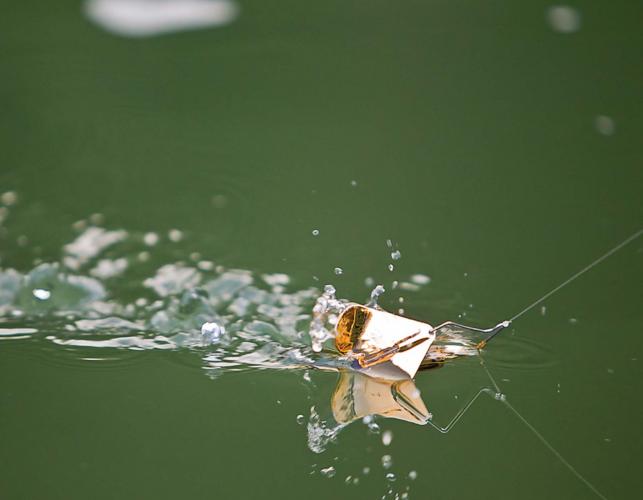
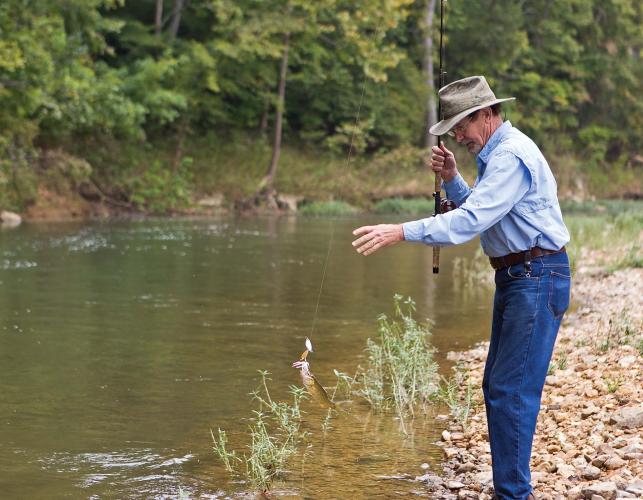
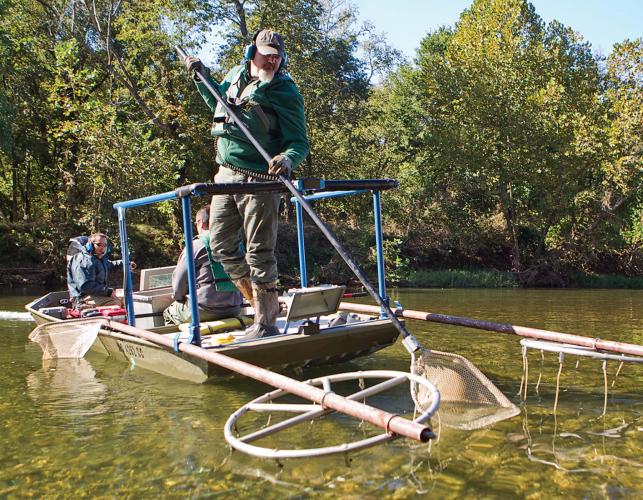
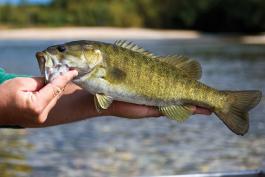

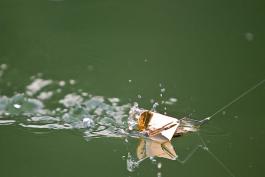


And More...
This Issue's Staff
Managing Editor - Nichole LeClair Terrill
Art Director - Cliff White
Staff Writer/Editor - Brett Dufur
Staff Writer - Jim Low
Photographer - Noppadol Paothong
Photographer - David Stonner
Designer - Stephanie Thurber
Circulation - Laura Scheuler






















